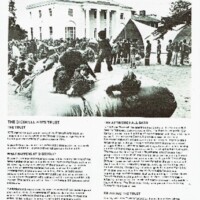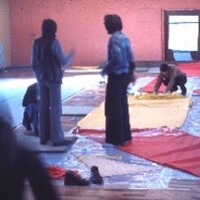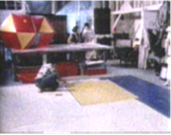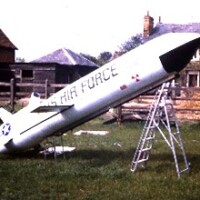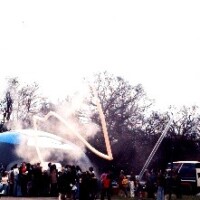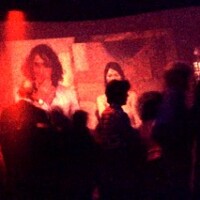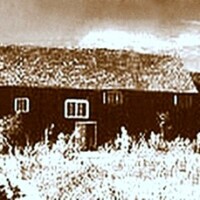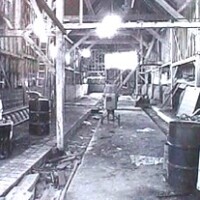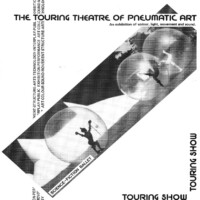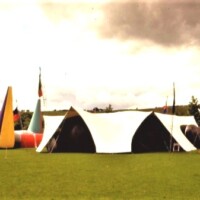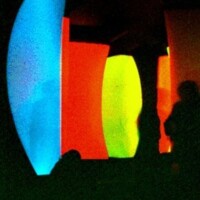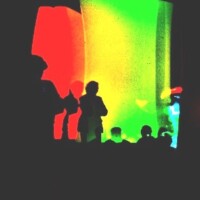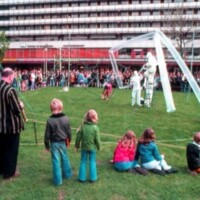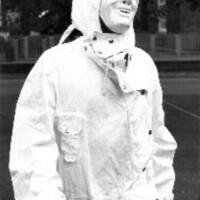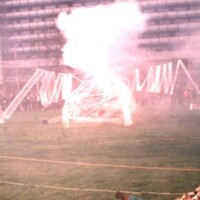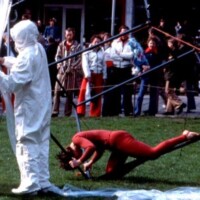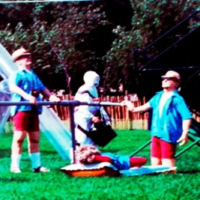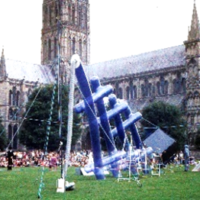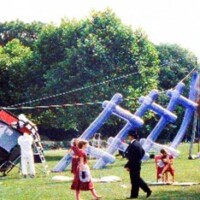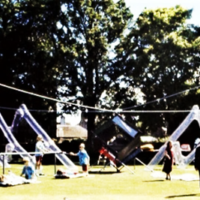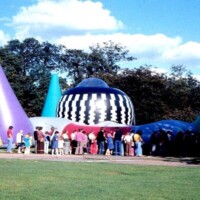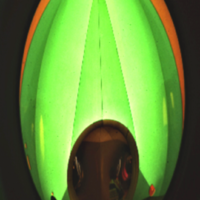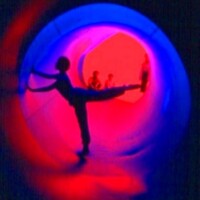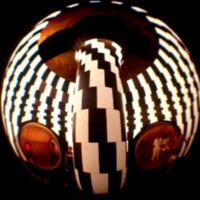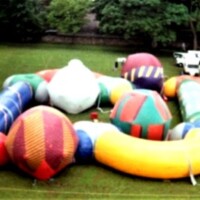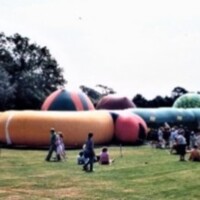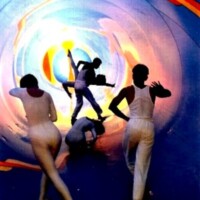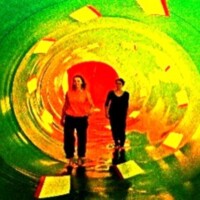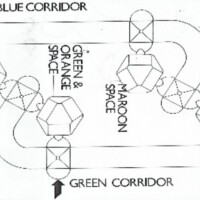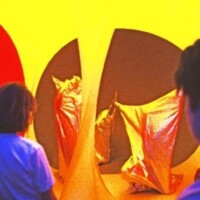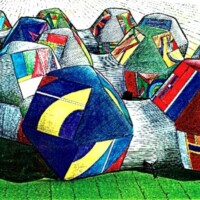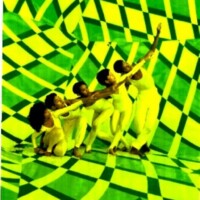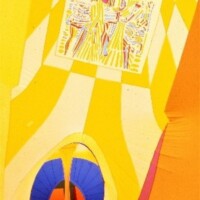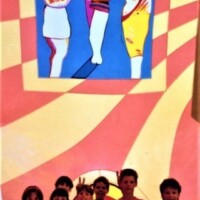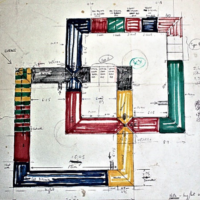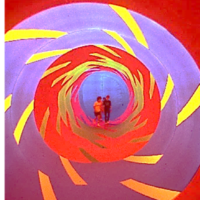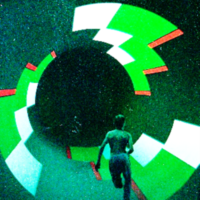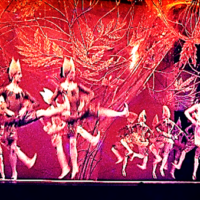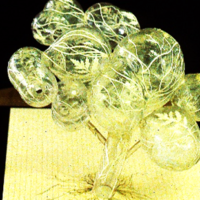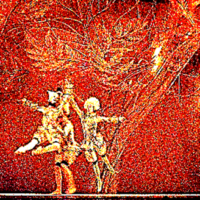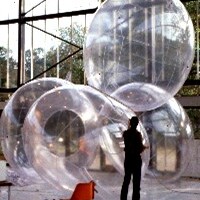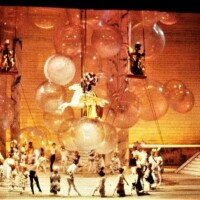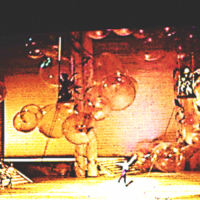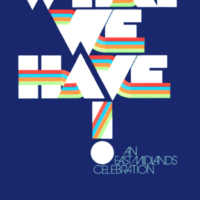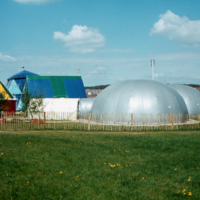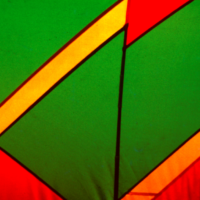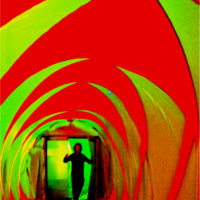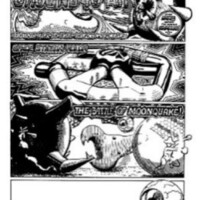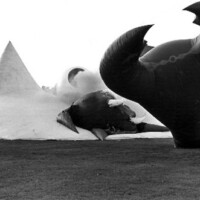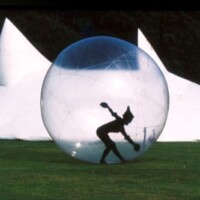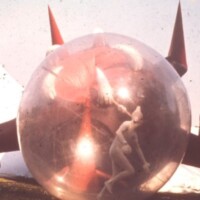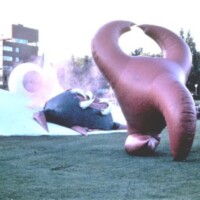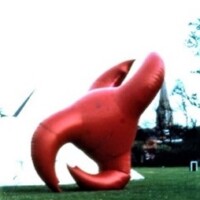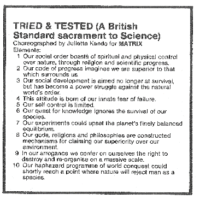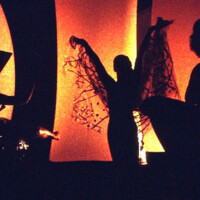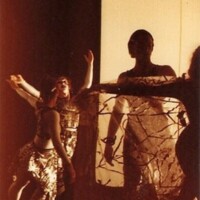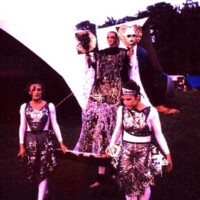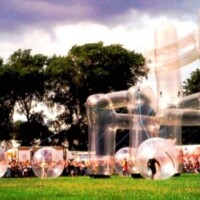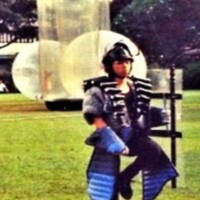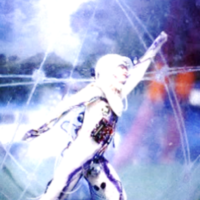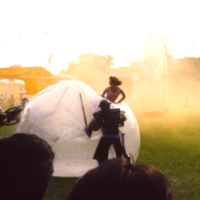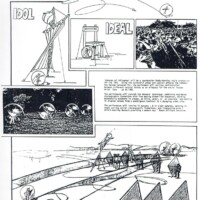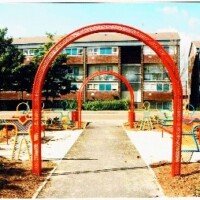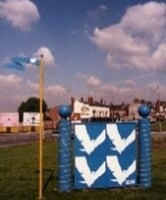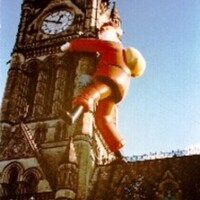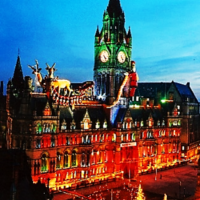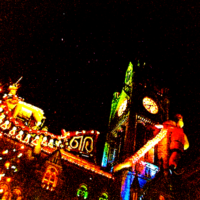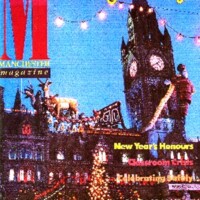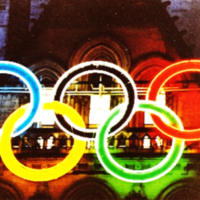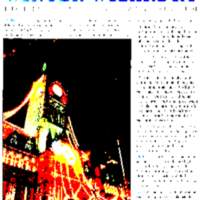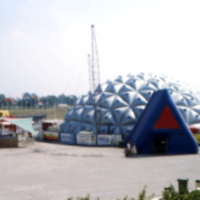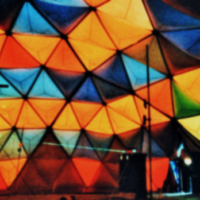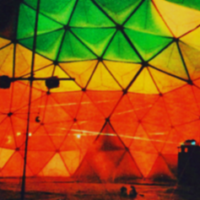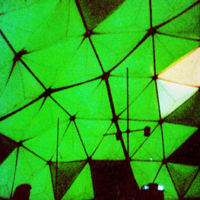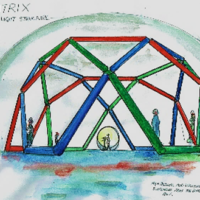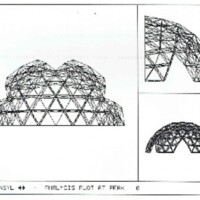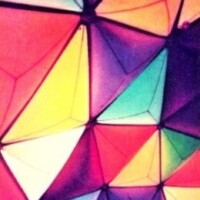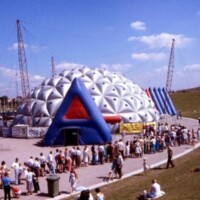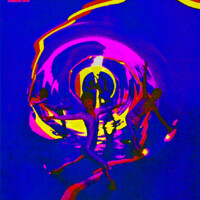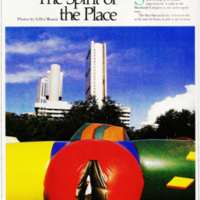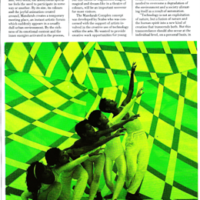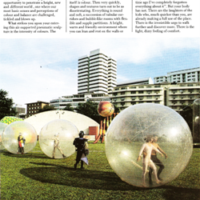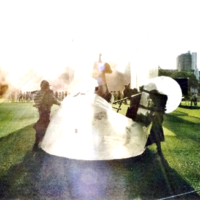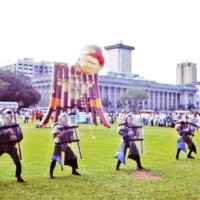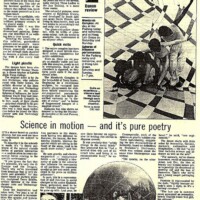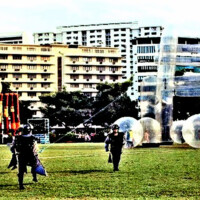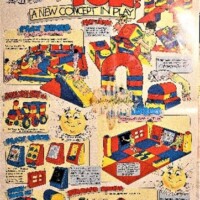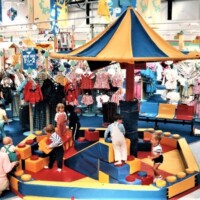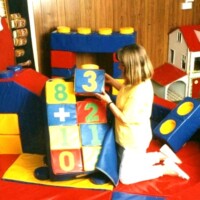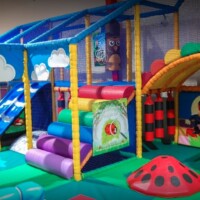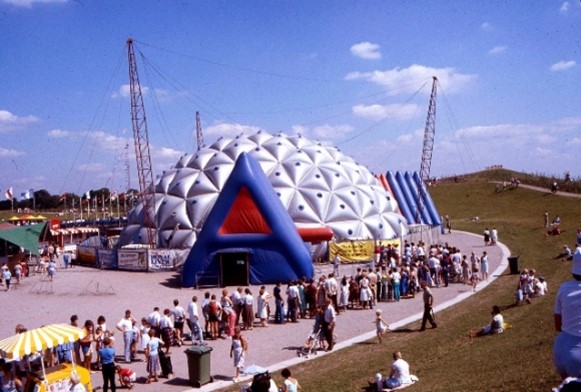
Resume Part TWO
A Change of Emphasis 1975 – 1989
1975 – 1982
The Interplay-Welwyn-Garden-City Project
Community workshops – action and events – Mobile multi-screen film space – Attimore Hall Barn Arts workshop
Following Hammersmith, I took up a three-year artist-in-residence workshop project at the Digswell Arts Trust (DAG). Funded by the Arts Council of Great Britain and Eastern Arts Association, it was called the Interplay-Welwyn Garden City Project. The scheme’s objective was to work with resident artists to develop creative activities in Welwyn Garden City and Hatfield.
The project later included establishing a new public art workshop facility in a barn renovated by the Commission for New Towns for the Panshanger Community Hall Trust. For this longer, more complex project, it was extended to a five-year residency. Obviously it was essential to create and retain a professional and dedicated project team.
1976 The Touring Theatre of Pneumatic Art
During my first residency in Rainham, a young volunteer, Roger Hutchinson, was introduced to me by Rainham Social Services. He had good natural graphic skills yet was unemployed and joined me for the duration of the Rainham project. Subsequently, I invited him to work full-time as a studio assistant at Hammersmith and on the Interplay-Welwyn Garden City Project.
Dependable administrative support and touring management were also essential. Due to the impending closure of the arts centre in St Albans, its director, David Townsend Jones, became available. So, I asked him to join the Welwyn Garden City project the following year in 1976. This new professional team gelled well and continued to work together effectively on the Interplay-WGC project and beyond.
Helping the community
Consequently, with our time at Welwyn Garden City extended to five years, we had a longer period of intense creative work. It also gave us the opportunity to train council youth workers and volunteers to set up regular programme of activities. In addition, we took part in events around London for One-2-One, a charity committed to opening up Victorian institutions, enabling mental health patients to become part of the community.
For WGC, we also arranged events in the town centre, including the touring Film Space, A Christmas Day in the Glasshouse, and the Festival of Air for KITE (a local community arts organisation). It was an opportunity to exhibit the work of The Touring Theatre of Pneumatic Art. And show the latest developments in my colour environments and performance pieces at a series of notable community shows.
The Film Space Project and our portable multi-screen cinema dome, proved very popular because there was no local cinema. So we travelled the area showing British Film Institute archived films and promoting local arts activities.
The Interplay-WGC project was enormously successful and improved the Digswell Arts Trust’s standing in the community. Thus achieving the long-term objective of the WGC project.
1976 Matrix Plane-space
Soft geometry kinetic lozenge plane-space, toured throughout the North West of England.
1976 – 1984 The work of The Theatre of Pneumatic Art multi-media touring show
During the latter half of the Digswell residency, the work of the Touring Theatre of Pneumatic Art developed very quickly. These shows exhibited my most recent work.
- Matrix Plane-space, a kinetic light environment, which took three years to construct.
- Mandarah Complex, a sunlit colour environment based on earlier experiments with Space Station Kolor, conceived and assembled at WGC.
The touring show also included a new version of the surreal constructivist piece Altarpiece. This more sophisticated version was titled Altarpiece Automated and toured throughout the northwest, supported by the Mid-Pennines Art Association. It was performed at Arts and Community Festivals throughout the UK and Europe from 1977-1987, as a unique multi-media visual art.
1977 Altarpiece: A Requiem du Printemps
I was invited to the Netherlands to present a new performance work for the Royal Celebrations in Rotterdam. For the event, I created a distinctly surreal constructivist dance – Altarpiece: A Requiem du Printemps. The improvised ‘Constructivist performance ballet’ visually explored the suffocation of creativity by mindless robotic industrial processes, starving our imagination and self-expression.
First performed in Rotterdam on a grass space at a shopping centre between tower blocks. It was further developed and presented as Altarpiece (Automated) (1979). The piece featured four-dancers interacting with a surreal set of pneumatic figures. It depicted the stages in the life of the dancer until, suffocated by conformity and obsession with consumerism, the dancer is replaced by an effigy.
1977 – 84 Mandarah Complex – a series of sunlit intense colour environments
“A world of pure intense colour, where air itself is colour and where the audience are actors in a dream“.
Adapted from Matrix 1 (1974), I developed a further two soft geometry sun lit colour environments. Constructed as inter-connected three-dimensional stained-glass spaces, the Mandarah Series – 1, 2 and 3, based on soft geometry were all different. They were visually stunning and very popular, being enjoyed by thousands of participants for over a decade.
1977 Mandarah 1 – Made in Welwyn Garden City
1982 Mandarah 2 – Made in Manchester
1983 Mandarah Bursary Scheme
Whilst in Manchester, to help further the creative concepts of the work, the project established a Mandarah Bursary Scheme. This enabled local artists to create their own spaces for Mandarah 2, funded by North West Art Association. Winners of the bursaries were:
- Cecile Elstein – Sculpture, Printer and Environmental Artist, and
- Alan Hughes, a lecturer at Wirral College of Art. Nowadays, his work is on display in art collections at the Universities of Liverpool, Leicester and the Williamson Art Gallery.
1984 Mandarah 3 – Constructed to test a new light-weight, reinforced PVC material
1978 – 1979 Public Art Commissions at the Attimore Hall Barn Arts Workshop
Once the newly renovated Attimore Hall Barn arts workshop was available, I felt confident to undertaking public art commissions. After showing our work on the Anglia TV Arial Arts programme, we had three major commissions between 1978 and 1979.
- Royal Ballet Company Solitaire Ballet set. Commissioned by the Royal Ballet Company to develop and construct an air structure stage set for the touring production of Solitaire. Choreography by Kenneth Macmillan with set design by Barry Kay,
- Paris Opera House Verdi’s Four Seasons Ballet. Similar to the Royal Ballet set, but larger. The commission was for a special soiree of Four Seasons celebrating the work of Kenneth MacMillan.
- What We Have Exhibition Domes. Construction of a two-domed exhibition space titled What We Have. The piece was for East Midlands Arts Association and included a colour space connecting corridor.
Solitaire – Royal Ballet Company. choreography Kenneth MacMillan, set design Barry Kay
Paris Opera House – Verdi’s Four Seasons Ballet
What We Have – East Midland Arts Touring Exhibition Domes and Caterpillar Corridor
The importance of Art commissions
Each of these public art commissions was significant. They provided additional funding for the work of the Touring Theatre of Pneumatic Art and extended my technical skills. Particularly complex pattern cutting to produce accurate air structure forms and understanding the pressure levels required for load bearing and safety.
The Touring Theatre of Pneumatic Art (TTPA Ltd)
By 1978 Interplay Structures Ltd had evolved into a unique multi-media touring arts company. So I decided to change the name of the touring Company to reflect the broader range of work. It was now a group of experimental public artists, musicians and dancers (as initially planned with the Digswell Arts Trust) performing in new portable colour environments on major national and international tours. The new company – The Touring Theatre of Pneumatic Art (TTPA Ltd) was regularly promoted in Grapevine, the Arts Council of GB publication.
TTPA Ltd was part publicly funded by the Arts Council of Great Britain in support of my research into the application of new materials and technology within the arts. Our community workshop projects received additional financial support from Local Authorities and regional arts associations for organising community events and training. It was also essential to seek commissions and sponsorship from industry to support and advance technical development.
Performances and events by TTPA attracted large, diverse audiences and the company was respected for being professional and thought-provoking. Recognised as a multi-media visual arts and performance company, TTPA worked with esteemed musicians (including Simon Weston, Lol Coxhill, Richard Attree), dancers (Virginia Taylor, Vivian Quay, Juliette Kando and Maxine Thomas) and a talented crew of technicians.
The company performed throughout the UK and Europe and represented the UK at the Singapore Festival of Arts in 1986.
1975 – 1985 Performance pieces written and directed for The Touring Theatre of Pneumatic Art
1975 The Battle of Moonquake
Described as ‘a science-fiction ballet…a spectacular dance fantasy for open spaces’ and ‘a modern morality play’.
1978 Tried and Tested Dance performance for Matrix Plane Space
Written by Terry W Scales, choreographed by Juliette Kando.
1985 Spheres of Influence dance performance for open space
Commissioned for the 1985 International Youth Year. The piece blended themes from particle physics with imagery from turbulent events of the mid-1980s, including the Battle of Orgreave Colliery (1984) and the Heysel Stadium disaster in 1985.
Spheres of Influence was also exhibited and performed throughout the UK and in Ireland, Germany, Holland, and finally at the International Singapore Arts Festival in 1986. It was a joint production with particle physics research by David Townsend Jones and choreography by dance lecturer Maxine Thomas of Loreto Sixth Form College, Manchester. The original music score was by Jamie Nicholson, a science graduate at Manchester University.
1982 – 1989 Made in Manchester
Manchester Arts & Technology Workshop (MATW)
The transition period after finishing the Interplay-WGC project to set up a new workshop residency proved difficult with more than one option in different regions, including Essex, Northampton, Liverpool and Manchester. Each option was taking time to make a decision and having proposals not approved was very unsettling.
For nearly a year, I had a temporary office in Liverpool with a young administrator, Basia Chlebik. We finally negotiated our move to Manchester with the full support of the Arts Council and Northwest Arts Association. It looked like being our final contribution to the Arts Council’s national devolution policy and Manchester was very welcoming.
This new workshop project was known as the Manchester Arts and Technology Workshop (MATW). It was funded by the Arts Council of GB, The Granada Trust, The Gulbenkian Foundation and the Northwest Arts Association. From the outset we provided training and employment opportunities and produced creative public art commissions, working with staff and trainees paid for by the Government Manpower Services Commission Community Enterprise scheme. Mostly local people of all ages who had been made redundant.
Public Commissions for Manchester City Council
Soon after opening the doors of MATW, Manchester City Council Landscape Architects Department asked us to take on the completion of a small metal sculptural fencing and seating arrangement. Designed by the Council architects it was to be installed in a local park promoting the Council’s City Centre nuclear free zone campaign. Despite a steep learning curve to source materials, etc., MATW successfully completed the project on time and on budget
1982 Manchester, Rochdale Road Linked Hands peace sculpture
1984 Manchester Town hall – The Largest Santa in the World
Manchester in the early 80s was working hard to become the lead city in the north of England on the world stage. This included a bid to host the next Olympics.
In 1984, Anthony Rae and Ruth Cooper from MCC’s City Centre marketing team contacted MATW and asked us to submit designs to refresh the city’s Christmas decorations in Albert Square and Piccadilly Gardens. The city centre team had come up with an idea to mount the largest Santa in the world on the iconic Manchester Town Hall clock tower.
An outline proposal was submitted which the Council amazingly accepted. It was a major project and the first of its kind in the UK. Working with the MSC trainee team MATW successfully completed the work well in advance of the December deadline.
The largest Santa in the world was Manchester’s ‘King Kong’ icon. The press and the people of Manchester enjoyed the annual antics as it was lifted by crane to the top of the tower at the start of the annual Manchester Christmas market celebrations.
1985 – Santa, Rooftop Reindeer and a Sleigh
The following year Manchester City Council approached MATW again to add new features. This time we proposed two massive reindeers and a sleigh mounted the full length of the roof on the opposite side.
It gave Manchester City Council, MATW, the Manpower Services Commissions and the city of Manchester worldwide publicity and recognition. MATW had also fulfilled its objectives of offering a unique creative facility, producing technically advanced public art works constructed by local unemployed people. After MATW closed in 1987, the Santa was re-developed and remained a unique feature of the town hall roof for over a decade
Subsequently, following the Santa success MATW started to receive further commissions from the City Council and other councils.
1985 – Manchester Olympic bid, Olympic Rings in neon and fabric
MATW was asked to create and install a large neon light and tensioned fabric Olympic Rings feature. This would be displayed on the central doorway to the Town Hall in support of Bob Scott’s 1985 bid to host the UK Olympics in Manchester.
1986 Piccadilly Gardens programmed festoon lighting towers
Four 60 metre high aluminium Triodetic masts with interlinked sweeping arcs of programmed coloured festoons were configured Christmas trees mounted in the centre of Piccadilly Gardens.
Public Art Commissions – Developing New Technical Services And Creative Skills
As a result of the City Council’s various commissions, MATW was providing work and practical training opportunities for an extraordinary range of creative technical skills. From drafting original design work to developing lighting circuitry for programmed lighting displays, from fabric structures to installation work.
At the time, I felt MATW was unique enough as a creative workshop to have a chance to take root and survive. Also, I genuinely believed there was a chance to see a new generation of public Arts Lab workshop facilities become a reality, undertaking creative commissions for local authorities.
However, I was acutely aware that despite the success of MATW, this project was the most recent publicly funded arts scheme in Manchester. As the Government was looking to cut public funding for the Arts in favour of private sponsorship, MATW was more likely to be the first to have its funding cut if something went wrong. Unfortunately, this is exactly what happened. I made what I now admit was a serious mistake – taking on the commission to create a Laser dome for the 1985 Liverpool International Garden Festival.
It was a highly political event. A flagship Government project, managed by Merseyside Development Corporation (MDC), that was due to be funded by the Government’s policy of industrial sponsorship.
1984 The Laser Dome for Liverpool International Garden Festival
The Matrix Cupola Kaleidoscopic Dome was a financial disaster. My simple artistic concept, based on decades of practical experience, was undermined by over-cautious and complex engineering. The enforced heavy-handed approach demanded by MDC’s insurers almost doubled the cost of the project, but too late in the contract negotiations. Naturally, this led to a large deficit and insufficient time to raise sponsorship. As a result, TTPA Ltd, the contracted company, was forced into liquidation. This was despite MATW completing and installing the structure, thanks to the dedicated commitment of our MATW workforce.
Liverpool International Garden Festival was deemed a huge success and attracted 3,380,000 visitors. When it opened the Laser Dome also proved extremely popular and was visited by in excess of 300,000 people.
A salutary tale
In 1984 TTPA employed Stephen Kingston as administrator, tour manager and publicity officer. He was an experienced and very energetic arts officer who had previously worked for North West Spanner Theatre Company. On joining TTPA, he had to quickly produce a fundraising campaign to raise business sponsorship for the Liverpool Dome project. Despite creating a very professional campaign, his efforts proved fruitless. At the time, the UK business world was not prepared to sponsor experimental arts schemes like the Cupola Dome or the Garden Festival.
It became apparent that the business sponsorship promoted by Merseyside Development Corporation during contract negotiations with TTPA would not materialise. Along with the additional increased construction costs caused by the structural engineering requirements, this subsequently led to TTPA’s bankruptcy and liquidation. With the liquidation of TTPA, I lost credibility with North West Arts, which inevitably undermined the support for MATW.
Sadly, Manchester Arts & Technology Workshop had to close in October 1987.
On reflection…
Considering we were active in Manchester for less than six years, TTPA and MATW should be proud of their achievements. In fact, before I left the northwest, we had one more, significant success.
In 1986, the MATW team had the accolade of representing the UK at The Singapore International Arts Festival. They would perform Mandarah 2 and Spheres of Influence, my last and most ambitious performance piece, commissioned for the International Year of Youth 1985.
When Stephen started working with TTPA, by necessity, he found himself fundraising for the Liverpool project. However, he also worked tirelessly for TTPA as tour manager, keeping the Company afloat during a difficult period, and running our touring show until 1987. At that point, I was a shadow of my former self, crushed after seventeen years of exciting and dynamic work. It was because of Stephen’s commitment that he successfully obtained our most prestigious commission, the touring show in Singapore.
1986 Spheres of Influence at Singapore International Arts Festival
Spheres of Influence was a powerful Busby Berkley-style extravaganza enacting a fable based on the interaction of the forces in the Universe in sub-particle physics, depicted as an allegory of our time represented by the State para-military forces attacking the striking miners in 1985.
1987 Post Public Funding of Creative Change
1988 – The Soft Brick Kit Company Ltd.
Despite the humiliation of losing my studio workshop, being unemployed and having to spend a year working for my major creditor, Mitco Peck of Wigan, ironically, I was eligible for a one-year Enterprise Allowance Scheme. EAS was a government job creation program offering a £60 weekly wage to people to develop a new business. I rose to the challenge. And in 1988 I developed a unique interlocking soft brick toy, based on one of my Hornsey College Pre-Diploma projects.
Robert Fairhurst, who was also on EAS setting up a soft furnishing business, helped create a prototype. Once made, with support from the Prince’s Trust, we exhibited the soft bricks at the International Toy Fair in Olympia.
Within a year of that show there was intense interest from the likes of Harrods and Hamleys Toy Store in London. So, I invited Graham and Lorraine Robinson, who ran a marketing company, Marketwise in Warrington, to promote Soft Brick Kit. Thankfully, they agreed. Now, as a result of their years of hard work, the Soft Brick Company Ltd is a multimillion-pound manufacturing company. They still make the soft toys in Warrington and create and install indoor play areas worldwide.
After moving to Wales, I had occasional involvement with the Company as it developed and matured, but remained a minority shareholder.
My transition to a new creative approach: light-scapes, luminaria and neon constructs

